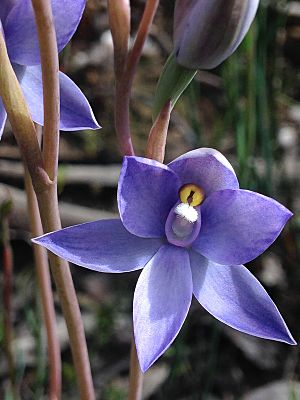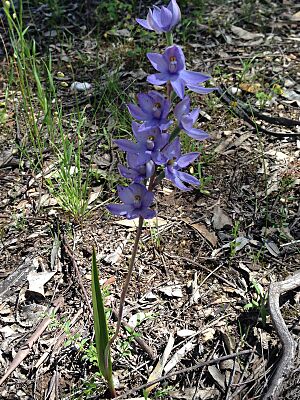Plains sun orchid facts for kids
Quick facts for kids Plains sun orchid |
|
|---|---|
 |
|
| Thelymitra megacalyptra near Strathfieldsaye | |
| Scientific classification | |
| Genus: |
Thelymitra
|
| Species: |
megacalyptra
|
| Synonyms | |
|
|
The Plains Sun Orchid (scientific name: Thelymitra megacalyptra) is a special type of orchid flower. It's only found in eastern Australia. This orchid has one upright, thick leaf. It can grow up to fifteen beautiful flowers. These flowers can be blue, purple, lilac, pink, or even white. They have cool white fluffy bits on the top part of their flower. Some experts also call it Thelymitra megcalyptra.
Contents
What the Plains Sun Orchid Looks Like
The Plains Sun Orchid is a perennial plant. This means it lives for more than two years. It grows from a tuber, which is like a small underground storage part. It has one leaf that stands straight up. This leaf is thick, leathery, and dark green. It can be from 10 to 35 centimeters (4 to 14 inches) long. The leaf is usually narrow and has a purplish base.
The plant grows a flowering stem that can be 20 to 60 centimeters (8 to 24 inches) tall. On this stem, there are usually two small leaf-like parts called bracts. It can have anywhere from two to fifteen flowers. Each flower is about 2.5 to 4.5 centimeters (1 to 1.8 inches) wide.
Flower Colors and Parts
The flowers can be blue, purple, lilac, pink, or white. The outer parts of the flower, called sepals and petals, are about 1.5 to 2.2 centimeters (0.6 to 0.9 inches) long.
Inside the flower, there's a special part called the column. It's pale blue, white, or pinkish. The top part of the column has a dark brown or blackish tip with a yellow end. It also has a V-shaped notch. The sides of the column have white, brush-like tufts. These tufts look a bit like tiny toothbrushes!
The flowers smell nice and stay open for a long time. They are pollinated by insects, which means insects help them make seeds. You can usually see these orchids flowering from August to November. They only open their flowers on sunny days.
How the Plains Sun Orchid Got Its Name
The Plains Sun Orchid was first officially described in 1879. A scientist named Robert Fitzgerald wrote about it. He found a sample of the plant near Dartmoor, a place in Australia.
The scientific name, Thelymitra megacalyptra, comes from old Greek words. "Mega" means "large" or "great". "Kalyptra" means "veil". So, its name hints at a "large veil" part of the flower.
Some plant experts still use the name Thelymitra megcalyptra for this orchid. However, the World Checklist of Selected Plant Families uses Thelymitra megacalyptra.
Where the Plains Sun Orchid Lives
The Plains Sun Orchid grows in different types of places. You can find it in forests, heathlands, and scrublands. Sometimes, many of these orchids grow together, forming large groups.
This orchid is found in several parts of eastern Australia:
- In New South Wales, it grows south from the Mount Kaputar National Park.
- It also lives in the Australian Capital Territory.
- You can find it in the drier areas of Victoria.
- It also grows in the south-east part of South Australia.


